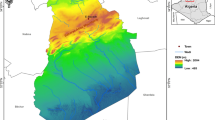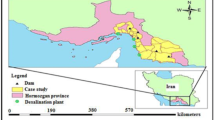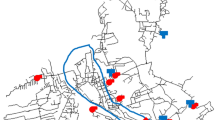Abstract
Disaster to water supply systems can occur due to failure of its raw water resource. Providing water supply in crisis period is a daunting task for water supply authorities. Flood or earthquake can damage a storage dam that supplies drinking water to a city. If one of the raw water resources, which supplies water to a city, is damaged in the disaster, the system must ensure that it receives water from the alternate raw water resource to maintain continuous water supply for the minimum life sustenance (say, 70 Liters Per Capita per Day, LPCD) by introducing an interlinking pipeline from the adjoining city’s water supply. In conventional water network solving, demand is fixed. It is presumed that the demand is always satisfied at the nodes and the nodal pressures and pipe flows are determined with respect to this known demand. All the traditional network solving algorithms are based on this assumption. When a major raw water resource supplying water to a city fails, pressure-deficient conditions are formed in the distribution system and alternative arrangement must be made to recover water supply. In such situation, the traditional methods are not enough to describe the behavior of pipe network. Therefore, pressure-dependent demand (PDD) analysis is an important tool used for analyzing the networks which are pressure deficient. This paper describes a small hypothetical model that simulates the disaster scenario due to failure of a water storage dam in an event of disaster such as flood. A PDD analysis of such situation has been carried out using WaterGEMS software. The paper also aims to prepare action plans of partial recovery of water supply in such crisis conditions.
Similar content being viewed by others
References
Abdy Sayyed MAH, Gupta R (2013) Predicting deficient condition performance of water distribution networks. Civ Eng Infrastruct J 46(2):161–173
Abdy Sayyed MAH, Gupta R, Tanyimboh TT (2014) Modelling pressure deficient water distribution networks in EPANET. Proc Eng 89:626–631
Alemtsehay GS, Tanyimboh TT (2014) Application of pressure-dependent EPANET extension. In: 11th international conference on hydro informatics, New York City, USA
Bhave PR, Gupta R (2006) Analysis of water distribution networks. Narosa Publishing House Pvt. Ltd, New Delhi
Dahasahasra SV, Mulay MR (2009) Crisis management of water supply—sustaining lives of 17 million. J IWWA XXXXI(2):85
Dahasahasra SV et al (2006) Disaster management—interlinking water supply systems in Mumbai metropolitan area (Part II). J IWWA XXXVIII(3):13
Gupta R (2015) History of pressure-dependent analysis of water distribution networks and its applications. In: Environmental and water resources congress, held at Austin, Texas
Islam MS, Sadiq R, Rodriguez MJ, Najjaran H, Hoorfar M (2014) Reliability assessment for water supply systems under uncertainties. J Water Resour Plan Manag ASCE 140:468–479
Mani A, Tabesh M, Zolfaghari MR (2013) Hydraulic performance of post-earthquake water distribution networks based on head driven simulation method. Water Sci Technol Water Supply 13(5):1281–1288
Manual on Water Supply and Treatment (1999) Published by central public health and environmental engineering organization (CPHEEO), 3rd edn. Ministry of Urban Development
Minakshi S, Ruchi K, Vishnu P (2014) Effect of pressure dependent demand on pipe network analysis: a case study. Int J Eng Sci Technol (IJEST) 6(1):7
Mohd Abbas H et al (2014) Modelling pressure deficient water distribution networks in EPANET. In: 16th conference on water distribution system analysis
Moosavian N, Jaefarzadeh MR (2013) Pressure-driven demand and leakage simulation for pipe networks using differential evolution. World J Eng Technol 1:49
Ozger SS, Mays LW (2003) A semi-pressure-driven approach to reliability assessment of water distribution networks. In: Proceedings of 30th IAHR congress, Thessaloniki, Greece, pp 345–352
Rasekh A, Brumbelow K (2014) Drinking water distribution systems contamination Management to reduce public health impacts and system service interruptions. Environ Model Softw 51:12–25
Shirzad A, Tabesh M, Farmani R, Mohammadi M (2013) Pressure-discharge relations with application to head-driven simulation of water distribution networks. J Water Resour Plan Manag 39(6):660–670
Shiv Kumar P, Prasad RK (2014) Simulation of water distribution network under pressure-deficient condition. J Water Resour Manag 28(3271–3290):92
Suribabu CR, Neelakantan TR (2011) Balancing reservoir-based approach for solution to pressure deficient water distribution networks. Int J Civ Struct Eng 2(2):639
Tabesh M, Tanyimboh TT, Burrows R (2002) Head-driven simulation of water supply networks. IJE Trans A Basics 15(1):11–22
Tabesh M, Shirzad A, Arefkhani V, Mani A (2014) A comparative study between modified and available demand driven based models for head driven analysis of water distribution networks. Urban Water J 11(3):221–230
Tanyimboh TT (2008) Robust algorithm for head-dependent analysis of water distribution systems. In: Proceedings of the 10th annual water distribution systems analysis conference. Kruger National Park, South Africa
Tanyimboh TT, Templeman AB (2010) Seamless pressure deficient water distribution system model. J Water Manag 163(8):389–396
Todini E (2012) Towards realistic extended period simulations (EPS) in looped pipe network. In: Eighth annual water distribution systems analysis symposium (WDSA), Cincinnati, Ohio, 27–30 August 2006
Walski T et al (2016) Verifying pressure dependent demand modelling. In: XVIII international conference on water distribution systems analysis, WDSA
Wu ZY, Walski T (2006) Pressure dependent hydraulic modelling for water distribution systems under abnormal conditions. In: IWA world water congress and exhibition, 10–14 Sept 2006, Beijing, China
Wu ZY et al (2006) Efficient pressure dependent demand model for large water distribution system analysis. In: 8th annual international symposium on water distribution system analysis, Cincinnati, Ohio
Wu Z et al (2009) Extended global-gradient algorithm for pressure-dependent water distribution analysis. J Water Resour Plan Manag ASCE 135(1):13–22
Author information
Authors and Affiliations
Corresponding author
Rights and permissions
About this article
Cite this article
Mulay, M.R., Dahasahasra, S.V. Partial Recovery of Water Supply in Disaster Using Pressure-Dependent Analysis. Iran J Sci Technol Trans Civ Eng 45, 481–490 (2021). https://doi.org/10.1007/s40996-020-00401-0
Received:
Accepted:
Published:
Issue Date:
DOI: https://doi.org/10.1007/s40996-020-00401-0










